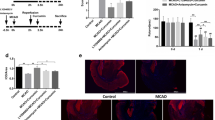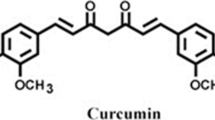Abstract
Toll-like receptors 2 and 4 (TLR2/4) and the downstream nuclear factor-kappa B (NF-κB) signaling pathway, which mediate the inflammatory reaction in cerebral ischemia, were demonstrated to be involved in the extension of cerebral infarction and the aggravation of ischemic brain damage. Reports showed that curcumin provides neuroprotection against ischemic brain damage. In this study, we investigated whether curcumin inhibits the activation of TLR2/4-NF-κB signaling pathway in rats of permanent focal cerebral ischemia. Adult male Sprague-Dawley rats underwent permanent middle cerebral artery occlusion (pMCAO). Curcumin was administered by intraperitoneal injection twice at 2 and 12 h after the onset of ischemia. Neurological deficit scores, cerebral infarct size, morphological characteristic, and cerebral water content were measured after 24 h of pMCAO. The enzymatic activity of myeloperoxidase (MPO) was assessed after 24 h of pMCAO. Expression of TLR2 and TLR4 in ischemic brain was determined by western blot. Expression of NF-κB p65 in ischemic brain was detected by immunohistochemistry and western blot. The release of tumor necrosis factor-α (TNF-α) and interleukin-1β (IL-1β) in blood was examined by ELISA. Curcumin significantly reduced neurological deficit scores, cerebral infarct size, neuronal damage, cerebral water content, and MPO activity. It also inhibited the expression of TLR2/4 and decreased the expression and activity of NF-κB p65 in rat brain. In addition, curcumin attenuated the release of TNF-α and IL-1β in blood. Our results suggest that curcumin reduces inflammatory reaction and brain damage in a rat model of permanent focal cerebral ischemia. The neuroprotective effect and anti-inflammatory property of curcumin in cerebral ischemia might be associated with the inhibition of TLR2/4-NF-κB signaling pathway.






Similar content being viewed by others
REFERENCES
Dirnagl, U., C. Iadecola, and M.A. Moskowitz. 1999. Pathobiology of ischaemic stroke: an integrated view. Trends in Neurosciences 22: 391–397.
Cuartero, M.I., I. Ballesteros, A. Moraga, F. Nombela, J. Vivancos, J.A. Hamilton, Á.L. Corbí, I. Lizasoain, and M.A. Moro. 2013. N2 neutrophils, novel players in brain inflammation after stroke: modulation by the PPARγ agonist rosiglitazone. Stroke 44: 3498–3508.
Liesz, A., W. Zhou, S.Y. Na, G.J. Hämmerling, N. Garbi, S. Karcher, E. Mracsko, J. Backs, S. Rivest, and R. Veltkamp. 2013. Boosting regulatory T cells limits neuroinflammation in permanent cortical stroke. Journal of Neuroscience 33: 17350–17362.
Hoffmann, O., J.S. Braun, D. Becker, A. Halle, D. Freyer, E. Dagand, E. Dagand, S. Lehnardt, and J.R. Weber. 2007. TLR2 mediates neuroinflammation and neuronal damage. Journal of Immunology 178: 6476–6481.
Ziegler, G., D. Harhausen, C. Schepers, O. Hoffmann, C. Rohr, V. Prinz, J. König, H. Lehrach, W. Nietfeld, and G. Trendelenburg. 2007. TLR2 has a detrimental role in mouse transient focal cerebral ischemia. Biochemical and Biophysical Research Communications 359: 574–579.
Caso, J.R., J.M. Pradillo, O. Hurtado, P. Lorenzo, M.A. Moro, and I. Lizasoain. 2007. Toll-like receptor 4 is involved in brain damage and inflammation after experimental stroke. Circulation 115: 1599–1608.
Tang, S.C., T.V. Arumugam, X. Xu, A. Cheng, M.R. Mughal, D.G. Jo, J.D. Lathia, D.A. Siler, S. Chigurupati, X. Ouyang, T. Magnus, S. Camandola, and M.P. Mattson. 2007. Pivotal role for neuronal Toll-like receptors in ischemic brain injury and functional deficits. Proceedings of the National Academy of Sciences of the United States of America 104: 13798–13803.
Tu, X.K., W.Z. Yang, S.S. Shi, C.H. Wang, G.L. Zhang, T.R. Ni, C.M. Chen, R. Wang, J.W. Jia, and Q.M. Song. 2010. Spatio-temporal distribution of inflammatory reaction and expression of TLR2/4 signaling pathway in rat brain following permanent focal cerebral ischemia. Neurochemical Research 35: 1147–1155.
Lan, L., J. Tao, A. Chen, G. Xie, J. Huang, J. Lin, J. Peng, and L. Chen. 2013. Electroacupuncture exerts anti-inflammatory effects in cerebral ischemia-reperfusion injured rats via suppression of the TLR4/NF-κB pathway. International Journal of Molecular Medicine 31: 75–80.
Barakat, W., N. Safwet, N.N. El-Maraghy, and M.N. Zakaria. 2014. Candesartan and glycyrrhizin ameliorate ischemic brain damage through downregulation of the TLR signaling cascade. European Journal of Pharmacology 724: 43–50.
Karikó, K., D. Weissman, and F.A. Welsh. 2004. Inhibition of toll-like receptor and cytokine signaling—a unifying theme in ischemic tolerance. Journal of Cerebral Blood Flow and Metabolism 24: 1288–1304.
Giordano, S., V. Darley-Usmar, and J. Zhang. 2013. Autophagy as an essential cellular antioxidant pathway in neurodegenerative disease. Redox Biology 2: 82–90.
Ahmad, N., S. Umar, M. Ashafaq, M. Akhtar, Z. Iqbal, M. Samim, and F.J. Ahmad. 2013. A comparative study of PNIPAM nanoparticles of curcumin, demethoxycurcumin, and bisdemethoxycurcumin and their effects on oxidative stress markers in experimental stroke. Protoplasma 250: 1327–1338.
Wu, J., Q. Li, X. Wang, S. Yu, L. Li, X. Wu, Y. Chen, J. Zhao, and Y. Zhao. 2013. Neuroprotection by curcumin in ischemic brain injury involves the Akt/Nrf2 pathway. PLoS One 8: e59843.
Shi, S.S., W.Z. Yang, X.K. Tu, C.H. Wang, C.M. Chen, and Y. Chen. 2013. 5-Lipoxygenase inhibitor zileuton inhibits neuronal apoptosis following focal cerebral ischemia. Inflammation 36: 1209–1217.
Bederson, J.B., L.H. Pitts, M. Tsuji, M.C. Nishimura, R.L. Davis, and H. Bartkowski. 1986. Rat middle cerebral artery occlusion: evaluation of the model and development of a neurologic examination. Stroke 17: 472–476.
Lin, T.N., Y.Y. He, G. Wu, M. Khan, and C.Y. Hsu. 1993. Effect of brain edema on infarct volume in a focal cerebral ischemia model in rats. Stroke 24: 117–121.
Yang, C., X. Zhang, H. Fan, and Y. Liu. 2009. Curcumin upregulates transcription factor Nrf2, HO-1 expression and protects rat brains against focal ischemia. Brain Research 1282: 133–141.
Zhao, J., S. Yu, W. Zheng, G. Feng, G. Luo, L. Wang, and Y. Zhao. 2010. Curcumin improves outcomes and attenuates focal cerebral ischemic injury via antiapoptotic mechanisms in rats. Neurochemical Research 35: 374–379.
Wang, Y.F., Y.T. Gu, G.H. Qin, L. Zhong, and Y.N. Meng. 2013. Curcumin ameliorates the permeability of the blood-brain barrier during hypoxia by upregulating heme oxygenase-1 expression in brain microvascular endothelial cells. Journal of Molecular Neuroscience 51: 344–351.
Singh, R., J. Bullard, M. Kalra, S. Assefa, A.K. Kaul, K. Vonfeldt, S.C. Strom, R.S. Conrad, H.L. Sharp, and R. Kaul. 2011. Status of bacterial colonization, Toll-like receptor expression and nuclear factor-kappa B activation in normal and diseased human livers. Clinical Immunology 138: 41–49.
Li, H.Y., Z.Y. Yuan, Y.G. Wang, H.J. Wan, J. Hu, Y.S. Chai, F. Lei, D.M. Xing, and L.J. Du. 2012. Role of baicalin in regulating Toll-like receptor 2/4 after ischemic neuronal injury. Chinese Medical Journal 125: 1586–1593.
Tu, X.K., W.Z. Yang, S.S. Shi, Y. Chen, C.H. Wang, C.M. Chen, and Z. Chen. 2011. Baicalin inhibits TLR2/4 signaling pathway in rat brain following permanent cerebral ischemia. Inflammation 34: 463–470.
ACKNOWLEDGMENTS
The National Natural Science Foundation of China (81100987), the Natural Science Foundation of Fujian Province of China (2011J05066), the Doctoral Program Foundation of Institutions of Higher Education of China (20113518120005), the Clinical Key Subject (Neurosurgery) Funding of Fujian Medical University, and the Key Laboratory (Neurosurgical Department) Funding from the Affiliated Union Hospital of Fujian Medical University supported this work.
Author information
Authors and Affiliations
Corresponding author
Rights and permissions
About this article
Cite this article
Tu, Xk., Yang, Wz., Chen, Jp. et al. Curcumin Inhibits TLR2/4-NF-κB Signaling Pathway and Attenuates Brain Damage in Permanent Focal Cerebral Ischemia in Rats. Inflammation 37, 1544–1551 (2014). https://doi.org/10.1007/s10753-014-9881-6
Published:
Issue Date:
DOI: https://doi.org/10.1007/s10753-014-9881-6




